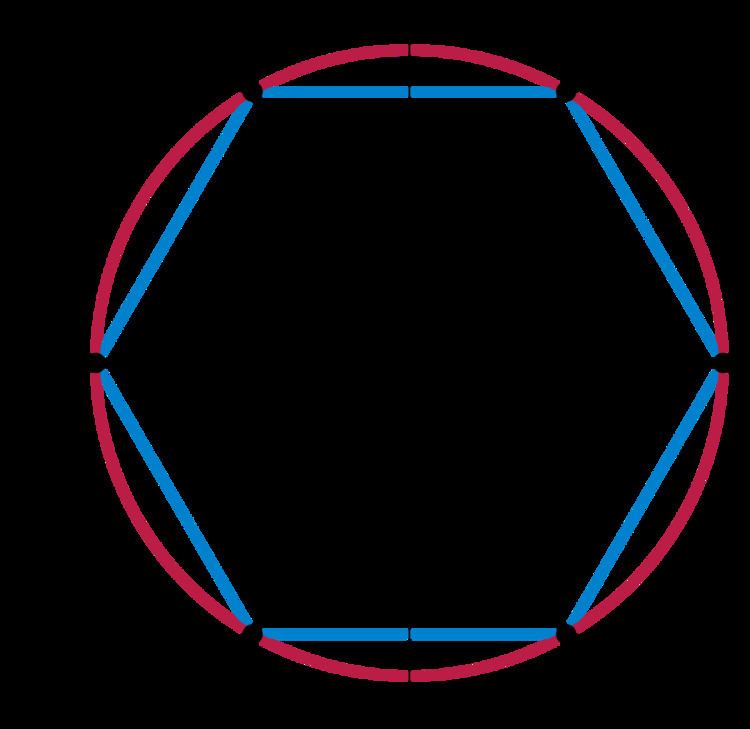 | ||
In mathematics, G2 is the name of three simple Lie groups (a complex form, a compact real form and a split real form), their Lie algebras
Contents
- History
- Real forms
- Dynkin diagram and Cartan matrix
- Roots of G2
- WeylCoxeter group
- Special holonomy
- Polynomial invariant
- Generators
- Representations
- Finite groups
- References
The compact form of G2 can be described as the automorphism group of the octonion algebra or, equivalently, as the subgroup of SO(7) that preserves any chosen particular vector in its 8-dimensional real spinor representation.
History
The Lie algebra
In 1893, Élie Cartan published a note describing an open set in
In 1900, Engel discovered that a generic antisymmetric trilinear form (or 3-form) on a 7-dimensional complex vector space is preserved by a group isomorphic to the complex form of G2.
In 1908 Cartan mentioned that the automorphism group of the octonions is a 14-dimensional simple Lie group. In 1914 he stated that this is the compact real form of G2.
In older books and papers, G2 is sometimes denoted by E2.
Real forms
There are 3 simple real Lie algebras associated with this root system:
Dynkin diagram and Cartan matrix
The Dynkin diagram for G2 is given by .
Its Cartan matrix is:
Roots of G2
Although they span a 2-dimensional space, as drawn, it is much more symmetric to consider them as vectors in a 2-dimensional subspace of a three-dimensional space.
One set of simple roots, for is:
(0,1,−1), (1,−2,1)Weyl/Coxeter group
Its Weyl/Coxeter group
Special holonomy
G2 is one of the possible special groups that can appear as the holonomy group of a Riemannian metric. The manifolds of G2 holonomy are also called G2-manifolds.
Polynomial invariant
G2 is the automorphism group of the following two polynomials in 7 non-commutative variables.
which comes from the octonion algebra. The variables must be non-commutative otherwise the second polynomial would be identically zero.
Generators
Adding a representation of the 14 generators with coefficients A..N gives the matrix:
It's exactly the Lie algebra of the group
Representations
The characters of finite-dimensional representations of the real and complex Lie algebras and Lie groups are all given by the Weyl character formula. The dimensions of the smallest irreducible representations are (sequence A104599 in the OEIS):
1, 7, 14, 27, 64, 77 (twice), 182, 189, 273, 286, 378, 448, 714, 729, 748, 896, 924, 1254, 1547, 1728, 1729, 2079 (twice), 2261, 2926, 3003, 3289, 3542, 4096, 4914, 4928 (twice), 5005, 5103, 6630, 7293, 7371, 7722, 8372, 9177, 9660, 10206, 10556, 11571, 11648, 12096, 13090….The 14-dimensional representation is the adjoint representation, and the 7-dimensional one is action of G2 on the imaginary octonions.
There are two non-isomorphic irreducible representations of dimensions 77, 2079, 4928, 28652, etc. The fundamental representations are those with dimensions 14 and 7 (corresponding to the two nodes in the Dynkin diagram in the order such that the triple arrow points from the first to the second).
Vogan (1994) described the (infinite-dimensional) unitary irreducible representations of the split real form of G2.
Finite groups
The group G2(q) is the points of the algebraic group G2 over the finite field Fq. These finite groups were first introduced by Leonard Eugene Dickson in Dickson (1901) for odd q and Dickson (1905) for even q. The order of G2(q) is q6(q6 − 1)(q2 − 1). When q ≠ 2, the group is simple, and when q = 2, it has a simple subgroup of index 2 isomorphic to 2A2(32), and is the automorphism group of a maximal order of the octonions. The Janko group J1 was first constructed as a subgroup of G2(11). Ree (1960) introduced twisted Ree groups 2G2(q) of order q3(q3 + 1)(q − 1) for q = 32n+1, an odd power of 3.
